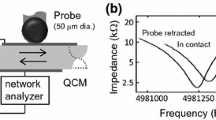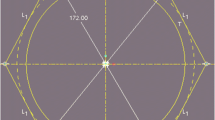Abstract
In this paper, the force-distance curves have been employed to investigate the force sensing properties of the probe-type microforce sensors. In the preliminary studies, two kinds of probe-type microforce sensors have been used to load the objects with dry and wetted surfaces. One is a developed piezoresistive cantilever force sensor with sensitivity of 35 μN/V and the other an atomic force microscope (AFM) cantilever beam probe with sensitivity of 10.4 nN/V. The force outputs corresponding to the regimes of approaching, indenting, and loading are obtained, and the properties of the stability in the approaching regime of the sensors, local mechanical behavior of the tested objects in the indenting regime, and the force sensing of the global samples are analyzed. Experimental results of this analysis are also presented.
Similar content being viewed by others
References
Davis H E, Troxell G E, Hauck G F W. The Testing of Engineering Materials. In: 4th ed. New York: McGraw-Hill, 1982. 68–178
Sharpe W N, Yuan B, Edwards R L. A new technique for measuring the mechanical properties of thin films. J Microelectromech Syst, 1997, 6(3): 193–199
Ogawa H, Suzuki K, Kaneko S, et al. Measurements of mechanical properties of microfabricated thin films. Proceedings of the IEEE Micro Electro Mechanical Systems (MEMS), 1997. 430–435
Haque M A, Saif M T A. In-situ tensile testing of nano-scale specimens in SEM and TEM. Exp Mech, 2002, 42(1): 123–128
Li X, Yang Y, Wei C. In situ and real-time tensile testing of thin films using double-field-of-view electronic speckle pattern interferometry. Meas Sci Technol, 2004, 15(1): 75–83
Lu S, Guo Z, Ding W, et al. In situ mechanical testing of templated carbon nanotubes. Rev Sci Instrum, 2006, 77(12): 125101
Wong E W, Sheehan P E, Lieber C M. Nanobeam mechanics: Elasticity, strength, and toughness of nanorods and nanotubes. Science, 1997, 277: 1971–1975
Yu M F, Lourie O, Dyer M J, et al. Strength and breaking mechanism of multiwalled carbon nanotubes under tensile load. Science, 2000, 287: 637–640
Tan E P S, Goh C N, Sow C H, et al. Tensile test of a single nanofiber using an atomic force microscope tip. Appl Phys Lett, 2005, 86(7): 073115
Ding W, Calabri L, Kohlhaas K M, et al. Modulus, fracture strength, and brittle vs. plastic response of the outer shell of arc-grown multi-walled carbon nanotubes. Exp Mech, 2007, 47(1): 25–36
Wang Z L, Song J. Piezoelectric nanogenerators based on zinc oxide nanowire arrays. Science, 2006, 312: 242–246
Kuzumaki T, Mitsuda Y. Nanoscale mechanics of carbon nanotube evaluated by nanoprobe manipulation in transmission electron microscope. Jpn J Appl Phys, 2006, 45(1A): 364–368
Tanikawa T, Kawai M, Koyachi N, et al. Force control system for autonomous micro manipulation. Proc IEEE Int Conf on Robot and Automat, 2001. 610–615
Fung C K M, Elhajj I, Li W J, et al. A 2-D PVDF force sensing system for micromanipulation and micro-assembly. Proc IEEE Int Conf on Robot and Automat, 2002. 1489–1494
Sun Y, Wan K T, Roberts K P, et al. Mechanical property characterization of mouse zona pellucida. IEEE Trans Nanobiosci, 2003, 2(4): 279–286
Sun Y, Fry S N, Potasek D P, et al. Characterizing fruit fly flight behavior using a microforce sensor with a new comb-drive configuration. J Microelectromech Syst, 2005, 14(1): 4–11
Bartsch M S, Federle W, Full R J, et al. Small insect measurement using a custom MEMS force sensor. IEEE Int Conf on Transducers, Solid-State Sensors, Actuators and Microsystems, 2003. 1039–1042
Behrens I, Doering L, Peiner E. Piezoresistive cantilever as portable micro force calibration standard. J Micromech Microeng, 2003, 13(4): S171–S177
Lu Z, Luo H, Chen P C Y, et al. An integrated probe sensor for microforce measurement. Meas Sci Technol, 2006, 17(4): 869–875
Li X, Su D, Zhang Z. A novel technique of microforce sensing and loading. Sens Actuator A-Phys, 2009, 153(1): 13–23
Su D, Li X. Fractionized calibration of the sample stage used in an AFM-probe mechanical testing system. Opt Lasers Eng, 2010, 48(11): 1076–1081
Sun C. Investigation of the performance of a microcantilever force sensor and its dependence on the structural scale (in Chinese). Bachelor Thesis. Tsinghua: Tsinghua University, 2010
Cappella B, Dietler G. Force-distance curves by atomic force microscopy. Surf Sci Rep, 1999, 34(1–3): 1–104
Author information
Authors and Affiliations
Corresponding author
Rights and permissions
About this article
Cite this article
Sun, C., Su, D. & Li, X. Investigation of loading and force sensing properties of a probe-type microforce sensor with force-distance curves. Sci. China Technol. Sci. 54, 1362–1370 (2011). https://doi.org/10.1007/s11431-011-4384-2
Received:
Accepted:
Published:
Issue Date:
DOI: https://doi.org/10.1007/s11431-011-4384-2




